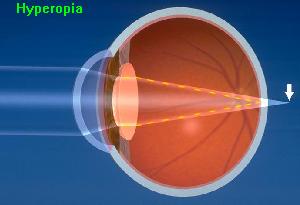The Farsighted
Eye
Hyperopia (i.e farsightedness) is much less common than myopia or
emmetropia. It is typically in the +1.00 to +4.00 diopter range, rarely it can be as high
as +8.00 diopters.
 In
contrast to myopia, hyperopia occurs when the eye is too short for the power of its
optical components. In hyperopia, the cornea is not steep enough, and light rays hit the
retina before they come into focus. In the illustration, the light rays are shown to focus
behind the eye (arrow). Distant objects appear blurred, and nearby objects are even more
fuzzy. Most farsighted individuals need corrective eyewear to see clearly at all
distances.
In
contrast to myopia, hyperopia occurs when the eye is too short for the power of its
optical components. In hyperopia, the cornea is not steep enough, and light rays hit the
retina before they come into focus. In the illustration, the light rays are shown to focus
behind the eye (arrow). Distant objects appear blurred, and nearby objects are even more
fuzzy. Most farsighted individuals need corrective eyewear to see clearly at all
distances.
Spectacle Correction:
Correction of hyperopia requires a lens which is convex (i.e.
thicker in the middle than the edges). This acts as a magnifier and causes objects to
appear larger by about 2% per diopter. This is why hyperopes wearing spectacles appear to
have "big" eyes. Optical abberations and decreased peripheral vision occur with
large amounts of hyperopia.
Contact Lens Correction:
Contact lenses reduce the optical problems associated with
spectacle lenses, but they have their own unique problems including the need for
cumbersome care solutions, corneal warpage, corneal hypoxia (lack of oxygen), corneal
infections, and eyelid allergies. Some people lose their ability to wear contact lenses -
particularly those who have dry or sensitive eyes. It is typical for contact lens
intolerance to occur at about the age of 40.
Surgical Correction:
Hyperopia has proven to be more difficult to treat
surgically than myopia. Diamond cuts into the cornea, similar to those of RK but in a
hexagonal pattern, have led to unpredictable results and an unacceptably high complication
rate. Early attempts to correct hyperopia by using the excimer laser to reshape the
surface of the cornea have been disappointing; however, new software and the introduction
of LASIK holds promise.
 In
contrast to myopia, hyperopia occurs when the eye is too short for the power of its
optical components. In hyperopia, the cornea is not steep enough, and light rays hit the
retina before they come into focus. In the illustration, the light rays are shown to focus
behind the eye (arrow). Distant objects appear blurred, and nearby objects are even more
fuzzy. Most farsighted individuals need corrective eyewear to see clearly at all
distances.
In
contrast to myopia, hyperopia occurs when the eye is too short for the power of its
optical components. In hyperopia, the cornea is not steep enough, and light rays hit the
retina before they come into focus. In the illustration, the light rays are shown to focus
behind the eye (arrow). Distant objects appear blurred, and nearby objects are even more
fuzzy. Most farsighted individuals need corrective eyewear to see clearly at all
distances.